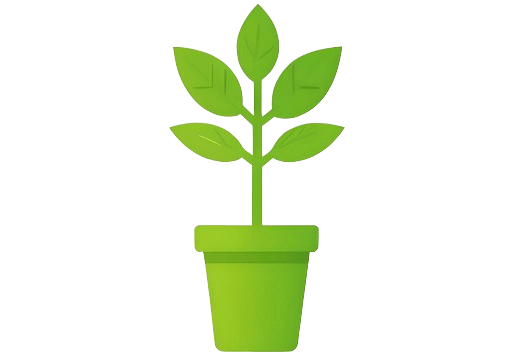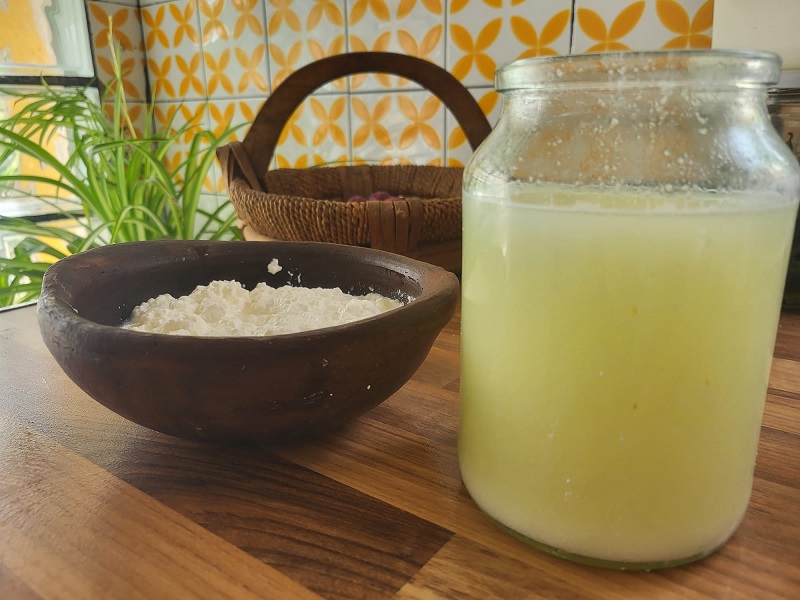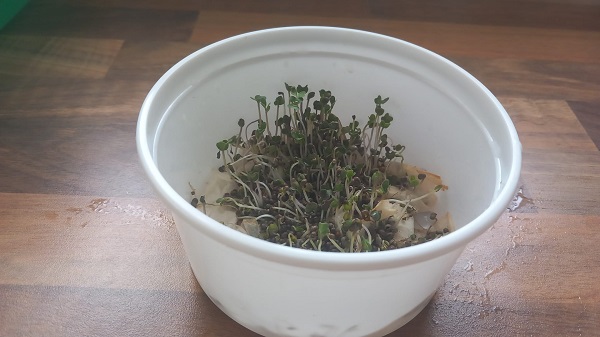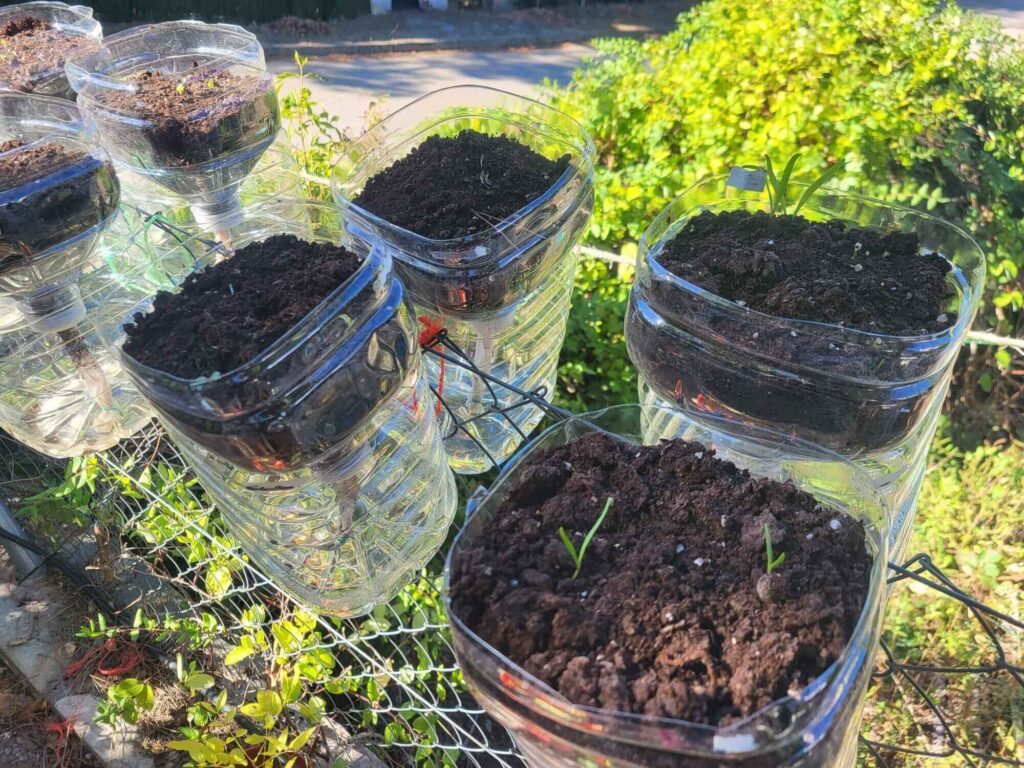In this article we are going to talk about one of our favorite biological preparations, due to its ease of preparation, and the great amount of utilities and benefits it has.
To do so, we will begin with a brief explanation, explore what LAB is, its uses in agriculture and home, how to prepare it and how to apply it correctly.
What is LAB?
It is the culture of lactic acid bacteria “lactobacillus“. These lactic acid bacteria are a group of bacteria (hundreds of genera and species), which convert lactose and other sugars into lactic acid.
They are commonly found in the soil and to a greater extent in the phyllosphere (microorganisms living on plants). That is why you will see that we will later recommend its use in a foliar form.
They play an important role in improving soil health and protecting plants against pathogens.
It is an essential preparation in Korean natural agriculture where they even call these bacteria the police of soil microorganisms.
Uses of LAB
Powerful biofungicide for soil or foliar application.
It is able to fight against a multitude of fungi such as botrytis cinerea, powdery mildew, or fungi that are established in our soils such as downy mildew, phytophthora or rhizotonia.
Lactobacillus produce antimicrobial compounds that inhibit the growth of soil pathogens such as harmful bacteria and fungi.
Accelerates the decomposition of organic matter
This allows us to use it in our compost, vermicompost, bokashi…
Decompacts, regenerates and decontaminates our soil
If there is an unbalanced population of microorganisms in our soil by adding lactic acid bacteria, we prevent these other harmful parasites from proliferating excessively. In turn, by decomposing organic matter it decompacts our soils and helps another group of bacteria called PGPR (which stimulate plant production and growth) to proliferate. They are also able to help in the decontamination of our soil by heavy metals (used on a regular basis applied in irrigation).
Probiotic for humans and animals
As you will see, the “cheese” obtained with our preparation, being free of lactose, can be given as a prize for our chickens, dogs… and even elaborated with the pertinent security measures we can consume it ourselves. Used sporadically, it is an excellent probiotic for everyone and improves the digestion of our animals.
Plant Growth Promotion
By improving nutrient availability and soil health, Lactobacillus promotes more vigorous and healthy plant growth.
Elimination of unpleasant odors
It is capable of neutralizing certain toxic gases and eliminates bad odors from pipes, drains, poultry houses, stables, compost…
Pesticide Use Reduction
The use of LAB reduces the need for chemical pesticides and fungicides, promoting a more sustainable and environmentally friendly agriculture.
How to Prepare
As we mentioned at the beginning, the preparation of LAB is a very simple and economical process that can be carried out at home with only 3 basic ingredients.
Ingredients Needed
- Rice
- Non-chlorinated water (e.g. rainwater or water that you have let stand for a couple of days in an uncovered container).
- Milk with lactose (any type of milk can be used, whole, skimmed, goat, cow, sheep…)
Steps to prepare it
The process consists of two simple steps:
Preparation of Rice Whey
Ingredients:
- Rice
- Water
Instructions:
- Fill a container with approximately 1/3 of rice.
- Add water: Cover all the rice and add a little more water, approximately 1/3 more than the amount of rice we have added.
- Stirring: Stir so that the water becomes cloudy and loosens the starch.
- Strain the whey: It is not necessary to wait a long time and we can proceed once the rice has been stirred to strain it into another container (The rice has only been soaked so you can use it to consume it without problems 😉).
- Fermentation: The rice already has lactic bacteria that together with those in the environment will begin to ferment eating the starch and growing in population.
To do this we will cover it with kitchen or oven paper, so that it can transpire and keep the container in a place that does not get sunlight and whose temperature is preferably around 20º C, from 3 to 5 days (at lower temperature we will need more days for fermentation to occur).
You will know it is done when you open it and notice a pleasant smell like milk or yogurt and a small layer of rice residue has appeared at the base (this may also occur to a lesser extent at the top) and it has a whitish color. If it smells bad or has a brown color, discard it.
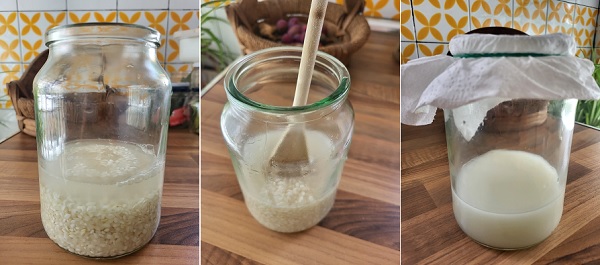
2. Preparation of Whey
Ingredients:
- Milk with lactose
Instructions:
- Add the Rice Whey to a container with milk: We will put milk in a container (about half of the pot to leave room for it to grow) and add 10% (of the amount of milk we have put) of our rice whey, leaving if possible the whey sediments in the previous container. 90% milk – 10% rice whey.
- Fermentation: Cover the mixture again with a breathable lid and let the mixture stand in a dark place for 3-5 more days, until the bacteria feed on the lactose and two layers are formed: one solid (curd) and one liquid (whey). Sometimes 3 layers are produced, this is also correct and we may see some bubbles, it should as with the rice whey smell good.
- Collection of the Whey: Next, separate the liquid whey from the solid part and strain it again in another container, trying not to mix the phases too much (carefully removing a little of the solid part).
The “cheese” obtained in this process can be eaten (carried out with the appropriate sanitary measures) by humans or by our animals, and they like it very much!
This is how the final process should look like:

Conservation
The whey obtained (LAB) could be used directly on our plants, but as we will not need large doses, it can last for a long time. We can conserve it in two ways.
- Directly in the refrigerator: It can last approximately 6 months if it is around 5ºC.
- Saturating with sugar: If we do not have or do not want to leave it in the refrigerator, this solution can be preserved for approximately 1 year. To do this, we will oversaturate the solution by adding sugar, preferably brown or whole sugar, until it no longer dissolves.
How to Apply LAB
Depending on the use we are going to give to our Lab, we will use doses with more or less concentrated product, always diluting it in water without chlorine.
The most common and its uses would be as follows
Probiotic for humans and animals
Maximum 1ml/l. For small animals, such as hens, we recommend lowering the dosage to 2-3 ml per 10l.
Foliar application or preventive use in soils
Dilute in non-chlorinated water approximately 2ml/l and apply preferably early in the morning or in the evening to avoid the intense heat of midday.
Soil application, fungi, decontamination…
Dilute 50 ml per liter in water without chlorine. For use in soils with heavy metals use regularly applied with irrigation.
Compost, Vermicompost, bokashi, foul odors
When, in short, we want the bacteria to settle quickly 50ml per liter of water.
